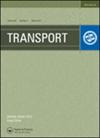基于综合MCDM模型的双车道路段交通风险评价
IF 1.3
4区 工程技术
Q3 TRANSPORTATION SCIENCE & TECHNOLOGY
引用次数: 2
摘要
几何特征对交通风险的影响通过识别道路上的冲突点、交通事故和任何其他不可预见的情况来反映出来,这些情况对交通参与者来说是固有的危险。为了确定风险最高的路段,有必要考虑一些影响风险的标准,并进行广泛的实证研究、分析和数据综合。本文使用综合多标准决策(MCDM)模型对波斯尼亚和黑塞哥维那(塞族共和国)境内的9段双车道道路进行了评估。为了确定8个评价标准对各断面的重要性,采用主客观模型,包括3种方法:(1)标准间相关性评价标准重要性(critical),(2)完全一致性评价方法(FUCOM)和(3)模糊枢轴对相对标准重要性评价方法(PIPRECIA)。使用这些方法获得的准则值的聚合产生最终的准则值。采用折衷方案法(MARCOS)对各剖面进行评价,确定其客观多样性。得到的结果通过大多数分析的输入参数确定了一个位置是极端危险的。风险最高的路段是Rudanka - Doboj路段(A4),该路段是105号公路道路基础设施的一部分。通过广泛的敏感性分析,验证了应用集成MCDM模型获得的结果。通过MARCOS方法中最初实施的单个方法来观察标准的权重。然后,与其他6种MCDM方法进行比较分析,并计算Spearman相关系数(SCC)作为敏感性分析中等级相关性的统计指标。并测定所得结果的标准差(Standard Deviation, STDEV)。本文章由计算机程序翻译,如有差异,请以英文原文为准。
EVALUATION OF TWO-LANE ROAD SECTIONS IN TERMS OF TRAFFIC RISK USING AN INTEGRATED MCDM MODEL
The impact of geometric characteristics on traffic risk is reflected through identifying conflict points on roads,traffic accidents, and any other unforeseen situation that is inherently hazardous for traffic participants. In order to identify the road sections with the highest risk, it is necessary to consider a number of criteria that affect risk, and conduct extensive empirical research, analysis and data synthesis. This paper evaluates 9 sections of two-lane roads in the territory of Bosnia and Herzegovina (the Republic of Srpska) using an integrated Multi-Criteria Decision-Making (MCDM) model.To determine the significance of 8 criteria for the evaluation of the sections, it was applied a subjective–objective model consisting of 3 methods: (1) CRiteria Importance Through Inter-criteria Correlation (CRITIC), (2) FUll COnsistency Method (FUCOM) and (3) fuzzy PIvot Pairwise RElative Criteria Importance Assessment (PIPRECIA). The aggregation of the criterion values obtained using the methods yielded the final criterion values. Measurement Alternatives and Ranking according to COmpromise Solution (MARCOS) method was used to evaluate the sections and determine their objective diversity. The obtained results identified one location as extremely hazardous by most of analysed input parameters. The section with the highest risk is the Rudanka – Doboj section (A4), which represents a section of the road infrastructure of the 105 road. The validation of the results obtained by applying the integrated MCDM model was performed through an extensive sensitivity analysis. The weights of criteria were observed through initially individual methods implemented in the MARCOS method. Then, a comparative analysis was performed with 6 other MCDM methods and Spearman’s Correlation Coefficient (SCC) was calculated as a statistical indicator of rank correlation in a sensitivity analysis. In addition,the Standard Deviation (STDEV) of the obtained results was determined.
求助全文
通过发布文献求助,成功后即可免费获取论文全文。
去求助
来源期刊

Transport
Engineering-Mechanical Engineering
CiteScore
3.40
自引率
5.90%
发文量
19
审稿时长
4 months
期刊介绍:
At present, transport is one of the key branches playing a crucial role in the development of economy. Reliable and properly organized transport services are required for a professional performance of industry, construction and agriculture. The public mood and efficiency of work also largely depend on the valuable functions of a carefully chosen transport system. A steady increase in transportation is accompanied by growing demands for a higher quality of transport services and optimum efficiency of transport performance. Currently, joint efforts taken by the transport experts and governing institutions of the country are required to develop and enhance the performance of the national transport system conducting theoretical and empirical research.
TRANSPORT is an international peer-reviewed journal covering main aspects of transport and providing a source of information for the engineer and the applied scientist.
The journal TRANSPORT publishes articles in the fields of:
transport policy;
fundamentals of the transport system;
technology for carrying passengers and freight using road, railway, inland waterways, sea and air transport;
technology for multimodal transportation and logistics;
loading technology;
roads, railways;
airports, ports, transport terminals;
traffic safety and environment protection;
design, manufacture and exploitation of motor vehicles;
pipeline transport;
transport energetics;
fuels, lubricants and maintenance materials;
teamwork of customs and transport;
transport information technologies;
transport economics and management;
transport standards;
transport educology and history, etc.
 求助内容:
求助内容: 应助结果提醒方式:
应助结果提醒方式:


